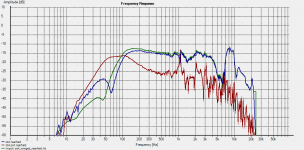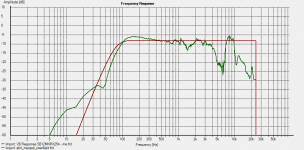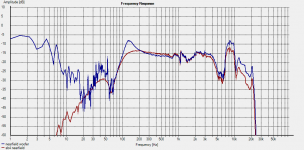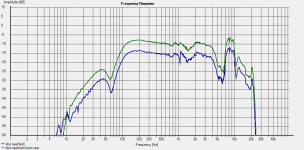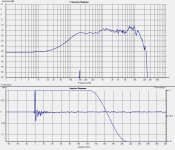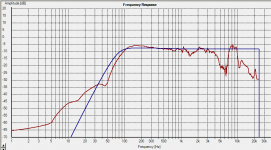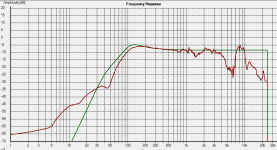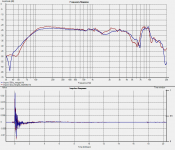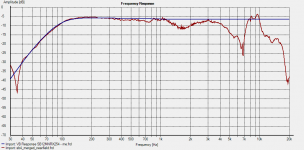Hmm that is a bit perplexing, one thing that I noticed is that the measurements show a peak at ≈40Hz as well as a peak at ≈125Hz and somewhat, a dip at ≈70Hz, this mirrors the port tuning, are you sure there isn't some error in the wiring somewhere? It's as if you might be performing a 2 channel freq resp measurement but with a jig set up for impedance or something.
Aus is 50Hz. 5th you may be 100% correct!! I left the speaker connected to the Walin jig and didn't plug it direct to the amp! The jig was no doubt still in impedance setup! I think I ran the mic direct to the sound card input, but certainly if there was an 8 ohm resistor in series with the driver it would explain the fact that the sim with 10 ohms series resistance seems to match what I see!
DOH!! But thank you!!!
I will try again this evening after work
edit: It would also explain why my levels were so low!! I was cranking up the output much higher than normal and scratching my head as to why the levels were low. double doh. (hard to tell with the hearing protection on). Just looking for the jig schematic to find out if indeed it puts the 8 ohms in series with the driver in impedance testing mode...
Tony.
DOH!! But thank you!!!
I will try again this evening after work
edit: It would also explain why my levels were so low!! I was cranking up the output much higher than normal and scratching my head as to why the levels were low. double doh. (hard to tell with the hearing protection on). Just looking for the jig schematic to find out if indeed it puts the 8 ohms in series with the driver in impedance testing mode...
Tony.
Last edited:
It was an ID10T error 
5th element wins the prize. It was my impedance jig stuffing things up :embarrased:
Tonights measurement is better. Still not perhaps quite what I thought it should be but better.
Definitely need to look at some sort of lining for the rear wall too, as I suspect that the big mess around 1Khz could be rear wall reflection, maybe not port resonance after all.
Blue is the woofer nearfield, red the port (still not sure how to get a long narrow port accurately) and orange is the two merged using speaker workshop.
edit: added sim vs nearfield. Might be time for me to try a groundplane measurement, haven't ever tried before... and third last nights vs tonights nearfield of the woofer (no port merging).
Tony.
5th element wins the prize. It was my impedance jig stuffing things up :embarrased:
Tonights measurement is better. Still not perhaps quite what I thought it should be but better.
Definitely need to look at some sort of lining for the rear wall too, as I suspect that the big mess around 1Khz could be rear wall reflection, maybe not port resonance after all.
Blue is the woofer nearfield, red the port (still not sure how to get a long narrow port accurately) and orange is the two merged using speaker workshop.
edit: added sim vs nearfield. Might be time for me to try a groundplane measurement, haven't ever tried before... and third last nights vs tonights nearfield of the woofer (no port merging).
Tony.
Attachments
Last edited:
ok and with some 1" thick very low density open cell foam on the back panel. definitely smooths out that glitch at 1Khz. Not sure If I will try the good stuff 
edit: also attached 30cm measurement gated (but still dodgy).
Tony.
edit: also attached 30cm measurement gated (but still dodgy).
Tony.
Attachments
Last edited:
That 1kHz glitch is port resonance. Note that it appears prominently in the port trace and only slightly in the driver trace. That kind of trace is typical of higher harmonics in MLTL's, but shouldn't appear in a BR.
Where are you gating your impulse? I think I see a bit of floor bounce in that trace. But hey, how much better do you want a gated trace to look? You a basically looking at the raw driver response and they aren't going to get much better. Do this: Smooth the gated trace to 1/3 octave. That's what your ears will hear. Now how do you like it?
Bob
Where are you gating your impulse? I think I see a bit of floor bounce in that trace. But hey, how much better do you want a gated trace to look? You a basically looking at the raw driver response and they aren't going to get much better. Do this: Smooth the gated trace to 1/3 octave. That's what your ears will hear. Now how do you like it?
Bob
It's nice to see that you managed to solve the problem. Small ported boxes can always be a little tricky, on the one hand you want minimal stuffing for the port, but on the other you want quite heavy stuffing for the mids. You definitely need to make gated farfield measurement to accurately see what these will do high up.
Hi Bob, Unibox calculates the port resonance as being around 1020Hz so it looks like it is. I thought that the fluctuations in frequency response around there looked very similar to theones I had with my 5" drivers in a sealed box where rear wall damping made a big difference. The foam seems to have lessened the effect without changing anything else though 
I might need to put some damping material on the port shelf itself. Being only 6mm mdf it may be being excited by the port resonance and amplifying the effect.
5th I will need to work out where I can do some decent gated measurements. I used to do them in the living room at my old unit, or on the balcony. This new place is bigger overall but doesn't have any large rooms. I might need to drag the hulk of a computer downstairs and outside to do some good measurements. Anyway I think I'm happy enough with the bracing now to seal up the back. I might play around a little with the port to see what effect it has.
I'm still uncertain about taking measurements of the port. It's easy with round ones, just stick the mic in the centre. That's what I did for this but I figure it won't be getting anywhere near the full spl that the port is producing. perhaps three measurements accorss the lenghth of the port, merge them and then merge as three ports of 1/3 the port area each??
Tony.
I might need to put some damping material on the port shelf itself. Being only 6mm mdf it may be being excited by the port resonance and amplifying the effect.
5th I will need to work out where I can do some decent gated measurements. I used to do them in the living room at my old unit, or on the balcony. This new place is bigger overall but doesn't have any large rooms. I might need to drag the hulk of a computer downstairs and outside to do some good measurements. Anyway I think I'm happy enough with the bracing now to seal up the back. I might play around a little with the port to see what effect it has.
I'm still uncertain about taking measurements of the port. It's easy with round ones, just stick the mic in the centre. That's what I did for this but I figure it won't be getting anywhere near the full spl that the port is producing. perhaps three measurements accorss the lenghth of the port, merge them and then merge as three ports of 1/3 the port area each??
Tony.
Calling Planet10 
Dave, this question is well and truly your domain
Is the deviation that I'm seeing in the measured nearfield response compared to my sim (using a round port) due to the high aspect ratio port?
The tuning is almost spot on compared to the sim at close to 70 hz but the spl curve is not.
my 70L 30 hz tuned boxes match the sim almost exactly, so I generally trust unibox to give me accurate results, however I'm now realising that I probably should have adjusted something for the different style port. The aspect ratio is close to 20:1 I read somewhere else that 8:1 or lower will model the same, however it didn't mention what changed when you went above that...
Tony.
Dave, this question is well and truly your domain
Is the deviation that I'm seeing in the measured nearfield response compared to my sim (using a round port) due to the high aspect ratio port?
The tuning is almost spot on compared to the sim at close to 70 hz but the spl curve is not.
my 70L 30 hz tuned boxes match the sim almost exactly, so I generally trust unibox to give me accurate results, however I'm now realising that I probably should have adjusted something for the different style port. The aspect ratio is close to 20:1 I read somewhere else that 8:1 or lower will model the same, however it didn't mention what changed when you went above that...
Tony.
OK thanks Dave, That's different to what I'm seeing so there might be something wrong with my nearfield measurements still or there may be something else going on! Anyway regardless it sounds pretty good so I probably should stop obsessing 
Blue is the unibox sim, red is the nearfield response with merged port response. The difference isn't huge but it is enough to bug me.
Upping the series resistance in the sim (second pic) to 2 ohms gets it a bit closer to the actual measured result, so maybe it is my dodgy alligator clips...
Anyway I won't get a chance to do anything more till the weekend most likely. I will report back if I work out what is going on!
Tony.
Blue is the unibox sim, red is the nearfield response with merged port response. The difference isn't huge but it is enough to bug me.
Upping the series resistance in the sim (second pic) to 2 ohms gets it a bit closer to the actual measured result, so maybe it is my dodgy alligator clips...
Anyway I won't get a chance to do anything more till the weekend most likely. I will report back if I work out what is going on!
Tony.
Attachments
Isn't that bump expected from the measurment technique?
You see this all the time:
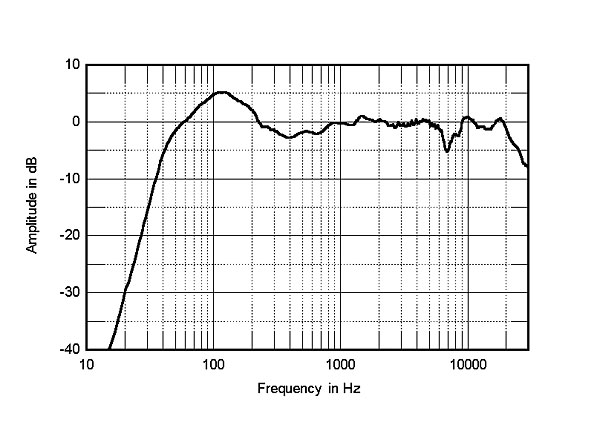
dave
You see this all the time:
The rise in the upper bass is mainly an artifact of the nearfield measurement technique used below 300Hz

dave
Bob, actually thinking about that don't you mean too small and too high? bigger and lower usually results in a droopy response... Leaving the volume the same (at 2.5L) and increasing the tuning to 110Hz in the sim gives me that rising effect.
I might try blocking off some of the port to lower the tuning frequency and see what happens. putting something down the middle would serve as a brace as well...
Tony.
I might try blocking off some of the port to lower the tuning frequency and see what happens. putting something down the middle would serve as a brace as well...
Tony.
Any bump towards the low end tends to get thrown into the
Statement from stereophile. It's simply a diplomatic way not to have to really discuss baffle step losses, the chosen amount of compensation used and any wonky cabinet alignments.
In absolute terms, the true stereophile bump occurs because you're measuring nearfield, on a loudspeaker, that has baffle step compensation applied. As you're nearfield the loss doesn't occur and you see a hump as a result.
In terms of the small bump that you're getting Tony, it is most likely caused by the box alignment. The two things that I would mention here is that adding in the port can be tricky. As you measure everything nearfield, a small difference in measurement distance can grossly affect the measured SPL between the port and the driver, this can screw up how accurate the combined response is. The other thing to watch out for are any tone controls in the mic preamp, as even when set to zero they may not be.
The first is easy to fiddle with as you can simply alter the level of the port and see if you can get things to match up better. I tend to ignore measuring the port and rely on an impedance measurement to make sure that the port is tuned to the correct frequency.
The second problem you can only sort out by bypassing the controls internally via a bit of handywork. The behringer preamp mixers are popular but some don't have defeatable tone controls.
If you are concerned about the alignment then I'd go back to the simulator, keep all the box parameters the same, but remove the port (ie use a closed box). Check what the simulator predicts, then measure your box with the port plugged and compare the two.
The rise in the upper bass is mainly an artifact of the nearfield measurement technique used below 300Hz
Statement from stereophile. It's simply a diplomatic way not to have to really discuss baffle step losses, the chosen amount of compensation used and any wonky cabinet alignments.
In absolute terms, the true stereophile bump occurs because you're measuring nearfield, on a loudspeaker, that has baffle step compensation applied. As you're nearfield the loss doesn't occur and you see a hump as a result.
In terms of the small bump that you're getting Tony, it is most likely caused by the box alignment. The two things that I would mention here is that adding in the port can be tricky. As you measure everything nearfield, a small difference in measurement distance can grossly affect the measured SPL between the port and the driver, this can screw up how accurate the combined response is. The other thing to watch out for are any tone controls in the mic preamp, as even when set to zero they may not be.
The first is easy to fiddle with as you can simply alter the level of the port and see if you can get things to match up better. I tend to ignore measuring the port and rely on an impedance measurement to make sure that the port is tuned to the correct frequency.
The second problem you can only sort out by bypassing the controls internally via a bit of handywork. The behringer preamp mixers are popular but some don't have defeatable tone controls.
If you are concerned about the alignment then I'd go back to the simulator, keep all the box parameters the same, but remove the port (ie use a closed box). Check what the simulator predicts, then measure your box with the port plugged and compare the two.
Thanks 5th there is no BSC as yet. I like the suggestion of modelling sealed and measuring with the port blocked off 
It's not a huge deal as they sound fine, but I like to get to a point where my sims correlate with what I do , and if they don't I like to get to the bottom of it! (read that as I'm overly obseesive )
)
When I was measuring my 70L BR boxes it wasn't matching and I spent a lot of time trying to work out why. In the end I'd dropped the mic at some point and damaged it, the LF response was affected. I tried a new mic and the sim matched the measured result
Tony.
It's not a huge deal as they sound fine, but I like to get to a point where my sims correlate with what I do , and if they don't I like to get to the bottom of it! (read that as I'm overly obseesive
When I was measuring my 70L BR boxes it wasn't matching and I spent a lot of time trying to work out why. In the end I'd dropped the mic at some point and damaged it, the LF response was affected. I tried a new mic and the sim matched the measured result
Tony.
I had a bit more of a play today. I haven't tried sealing up the port yet. but I did try blocking roughly half of it off (in the middle) to get two separate ports. This dropped the box tuning to around 55hz (both in the sim and in actual measurements).
The FR flattened out a bit, though the difference is not that great. Interestingly it has a minimal effect on the transient response as well. It does however affect the curve up higher, though obviously with a NF measurement the higher frequencies can't really be trusted.
Apart from the fact that my port area halved (and there would be potentially more problems with port noise) This doesn't seem like a bad option.
I'm still rather stumped at how different the results are to the modeled response, but one thing is nice, the design is not too sensitive to box tuning!! I'm wondering if I really pushed the limits a bit far with how small a box I could build, and the sim gets inaccurate when pushing the boundaries this far.
Blue trace is with the lower 55Hz tuning, red is the original 70Hz. I Iike the rolloff of the lower tuned box better.
Tony.
The FR flattened out a bit, though the difference is not that great. Interestingly it has a minimal effect on the transient response as well. It does however affect the curve up higher, though obviously with a NF measurement the higher frequencies can't really be trusted.
Apart from the fact that my port area halved (and there would be potentially more problems with port noise) This doesn't seem like a bad option.
I'm still rather stumped at how different the results are to the modeled response, but one thing is nice, the design is not too sensitive to box tuning!! I'm wondering if I really pushed the limits a bit far with how small a box I could build, and the sim gets inaccurate when pushing the boundaries this far.
Blue trace is with the lower 55Hz tuning, red is the original 70Hz. I Iike the rolloff of the lower tuned box better.
Tony.
Attachments
OK I think I have finally worked out what is going on re the sim not matching the reality. I will do some further tests to verify but maybe not till the weekend.
It suddenly dawned on me that I should try the sim with nothing other than a higher driver fs and see what happened. I chose 70hz instead of the 61Hz that I had measured. what do you know but the sim matches the measured response almost exactly!
The woofer I have been measuring with is the one that I did not do 12 hours of breakin on. I only did about 10 minutes of 45Hz on it before measuring the T/S params (which seemed to be enough and was the recommended method on the SB website). I should do the same before doing a nearfield measurement and see what happens. I suspect that the woofer returns to it's un-broken in behaviour when it has only had such a short breakin period!
Tony.
It suddenly dawned on me that I should try the sim with nothing other than a higher driver fs and see what happened. I chose 70hz instead of the 61Hz that I had measured. what do you know but the sim matches the measured response almost exactly!
The woofer I have been measuring with is the one that I did not do 12 hours of breakin on. I only did about 10 minutes of 45Hz on it before measuring the T/S params (which seemed to be enough and was the recommended method on the SB website). I should do the same before doing a nearfield measurement and see what happens. I suspect that the woofer returns to it's un-broken in behaviour when it has only had such a short breakin period!
Tony.
Attachments
- Status
- This old topic is closed. If you want to reopen this topic, contact a moderator using the "Report Post" button.
- Home
- Loudspeakers
- Full Range
- SB acoustics SB12MNRX25-4 "full range" Build thread
